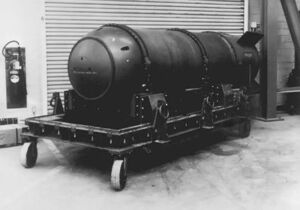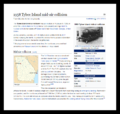1958 Tybee Island mid-air collision (nonfiction): Difference between revisions
No edit summary |
No edit summary |
||
| Line 10: | Line 10: | ||
<gallery> | <gallery> | ||
File:1958_Tybee_Island_mid-air_collision_-_infographic.png|1958 Tybee Island mid-air collision - Wikipedia screenshot. | |||
</gallery> | </gallery> | ||
== Fiction cross-reference == | == Fiction cross-reference == | ||
* [[Crimes against physical constants]] | |||
* [[Gnomon algorithm]] | |||
* [[Gnomon Chronicles]] | |||
== Nonfiction cross-reference == | == Nonfiction cross-reference == | ||
External links | * [[Weapon (nonfiction)]] | ||
== External links == | |||
* [https://en.wikipedia.org/wiki/1958_Tybee_Island_mid-air_collision 1958 Tybee Island mid-air collision] @ Wikipedia | * [https://en.wikipedia.org/wiki/1958_Tybee_Island_mid-air_collision 1958 Tybee Island mid-air collision] @ Wikipedia | ||
Revision as of 06:26, 5 February 2021
The Tybee Island B-47 crash was an incident on February 5, 1958, in which the United States Air Force lost a 7,600-pound (3,400 kg) Mark 15 nuclear bomb in the waters off Tybee Island near Savannah, Georgia, United States.
During a practice exercise, an F-86 fighter plane collided with the B-47 bomber carrying the bomb. To protect the aircrew from a possible detonation in the event of a crash, the bomb was jettisoned.
Starting on February 6, 1958, the Air Force 2700th Explosive Ordnance Disposal Squadron and 100 Navy personnel equipped with hand held sonar and galvanic drag and cable sweeps mounted a search. On April 16, the military announced the search had been unsuccessful.
Based on a hydrologic survey, the bomb was thought by the Department of Energy to lie buried under 5 to 15 feet (2 to 5 m) of silt at the bottom of Wassaw Sound.
In the News
Fiction cross-reference
Nonfiction cross-reference
External links
- 1958 Tybee Island mid-air collision @ Wikipedia

